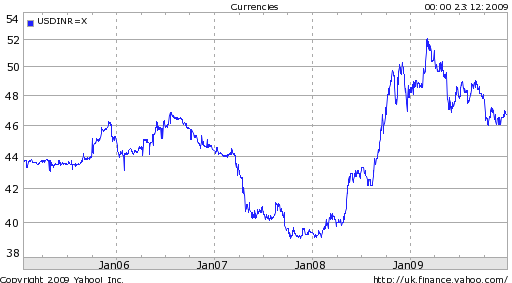December 24th 2009
Indian Rupee’s Rise is Sustainable
While the Indian Rupee has risen more than 10%, since bottoming in March, it has increased only 4.3% in value in the year-to-date. Still, given how turbulent the first few months of 2009 were (a continuation of 2008, really), this modest appreciation was actually the third highest, among Asian currencies, behind only the Indonesian Rupiah and Korean Won.

For those of you that don’t regularly follow the Rupee (to be fair, I probably fall into this category), it has basically ebbed and flowed over the last couple years in accordance with risk appetite, hardly breaking ranks with other emerging market currencies. It rose to record highs in 2007, only to lose 30% of its value in 2008 as the credit crisis exploded. In 2009, as I pointed out above, it has staged a modest recovery, as investors have hungrily poured money back into emerging markets.
In fact, the benchmark Indian stock market index has risen 79% this year, its best performance since 1991. The bond market has also been performing well, thanks to a recent upgrade by Moody’s of the government’s sovereign local currency debt. “Moody’s said the move reflects ‘increasing evidence that the Indian economy has demonstrated its resilience to the global crisis and is expected to resume a high growth path with its underlying credit metrics relatively intact.’ ” As a result, foreign capital, some of which is bound to be speculative, is pouring into India. $100 million a day is being plowed into Indian stocks by foreign funds.
Analysts remain extremely optimistic about near-term prospects of India, partly because of its association with China (termed “Chindia.”) “India’s exports climbed in November for the first time in 14 months after sliding an average 21 percent since October 200…Overseas shipments rose 18 percent to $13.3 billion from a year earlier.” The result is blazing GDP growth, clocked at 7.9% in the recent quarter. Interest rates are already a healthy 3.25%, and can be expected to rise in the near-term as the economic recovery continues to cement itself.
Certain risks remain, namely that the government is spending money like there’s no tomorrow. It will borrow the equivalent of $100 Billion this year to finance a record budget deficit, equal to 6.8% of GDP. Compared to other economies, however, this is hardly remarkable, which is why India’s sovereign credit rating was upgraded despite the rising debt. “Moody’s said the government’s debt trajectory was stable and the government had high debt financing capability.”
Going forward, forex traders are relatively conservative in their forecasts for the Rupee, with consensus estimates for the currency to remain relatively flat during the course of the next year. This is surprising, given that it remains well off of its 2007 highs and thus, relatively cheap. Perhaps, its a sign that investors are nervous about the Indian government’s lack of a coherent long-term plan. Perhaps, it reflects uncertainty about bubbles that are forming in other corners of emerging markets. Probably, it shows that despite all of the progress that was made in 2009 towards containing the credit crisis, investors still remain vigilant, and are hedging their bets accordingly.
More about this next time.



